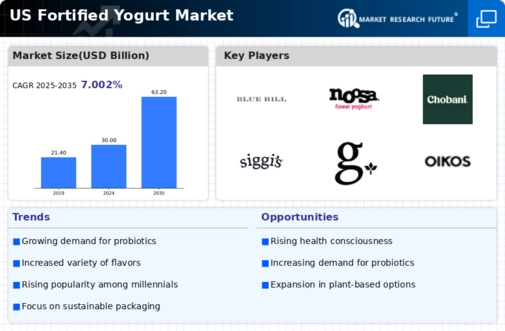Rising Health Consciousness
The fortified yogurt market is experiencing a notable surge in demand driven by an increasing awareness of health and wellness among consumers. As individuals become more health-conscious, they actively seek products that offer nutritional benefits. Fortified yogurt, enriched with vitamins and minerals, aligns with this trend, appealing to those looking to enhance their diets. According to recent data, the fortified yogurt market is projected to grow at a CAGR of approximately 6.5% over the next five years. This growth is indicative of a broader shift towards healthier eating habits, where consumers prioritize functional foods that contribute to overall well-being. The fortified yogurt market is thus positioned to capitalize on this trend, as manufacturers innovate to meet the evolving preferences of health-oriented consumers.
Innovations in Flavor and Texture
The fortified yogurt market is experiencing a wave of innovation, particularly in flavor and texture, which is crucial for attracting and retaining consumers. As competition intensifies, manufacturers are experimenting with unique flavor combinations and textures to differentiate their products. This innovation is essential in a market where taste and sensory experience significantly influence purchasing decisions. Recent surveys indicate that 70% of consumers are more likely to try new yogurt products if they offer exciting flavors. The fortified yogurt market is thus focusing on creative formulations that not only enhance nutritional value but also provide a delightful eating experience, potentially leading to increased sales and market share.
Increased Demand for Functional Foods
The fortified yogurt market is benefiting from a growing consumer preference for functional foods that provide additional health benefits beyond basic nutrition. This trend is fueled by a desire for products that support specific health goals, such as improved digestion, enhanced immunity, and better bone health. Fortified yogurt, often containing probiotics, prebiotics, and added nutrients, caters to this demand. Market analysis indicates that the functional food sector is expected to reach a valuation of $275 billion by 2025, with fortified yogurt playing a significant role in this expansion. The fortified yogurt market is thus likely to see increased competition as brands strive to differentiate their offerings through innovative formulations and marketing strategies that highlight the health benefits of their products.
E-commerce Growth and Online Shopping Trends
The fortified yogurt market is increasingly influenced by the rise of e-commerce and online shopping trends. As consumers become more accustomed to purchasing groceries online, the demand for convenient and accessible options is growing. This shift presents an opportunity for the fortified yogurt market to expand its reach through online platforms, allowing brands to connect with a wider audience. Data shows that online grocery sales are expected to account for 25% of total grocery sales by 2025. Consequently, fortified yogurt brands are likely to invest in digital marketing strategies and partnerships with e-commerce platforms to enhance visibility and drive sales, adapting to the changing shopping behaviors of consumers.
Growing Popularity of Plant-Based Alternatives
The fortified yogurt market is witnessing a shift towards plant-based alternatives, driven by changing dietary preferences and an increasing number of consumers adopting vegan or vegetarian lifestyles. This trend is not only about health but also encompasses ethical and environmental considerations. Plant-based fortified yogurts, made from almond, coconut, or soy, are gaining traction as they offer similar nutritional benefits while appealing to a broader audience. Recent statistics suggest that the plant-based yogurt segment is expected to grow by over 20% in the next few years. The fortified yogurt market is adapting to this shift by expanding product lines to include plant-based options, thereby attracting a diverse consumer base and enhancing market growth.























Leave a Comment